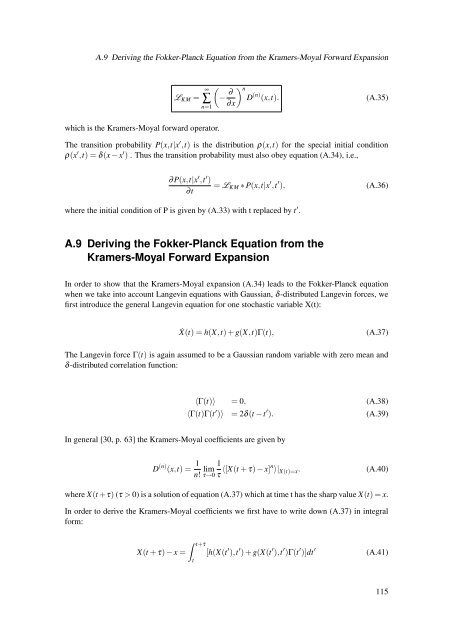Diffusion Processes with Hidden States from ... - FU Berlin, FB MI
Diffusion Processes with Hidden States from ... - FU Berlin, FB MI
Diffusion Processes with Hidden States from ... - FU Berlin, FB MI
Create successful ePaper yourself
Turn your PDF publications into a flip-book with our unique Google optimized e-Paper software.
A.9 Deriving the Fokker-Planck Equation <strong>from</strong> the Kramers-Moyal Forward ExpansionL KM =∞∑n=1which is the Kramers-Moyal forward operator.(− ∂ ∂x) nD (n) (x,t). (A.35)The transition probability P(x,t|x ′ ,t) is the distribution ρ(x,t) for the special initial conditionρ(x ′ ,t) = δ(x − x ′ ) . Thus the transition probability must also obey equation (A.34), i.e.,∂P(x,t|x ′ ,t ′ )∂twhere the initial condition of P is given by (A.33) <strong>with</strong> t replaced by t ′ .= L KM ∗ P(x,t|x ′ ,t ′ ), (A.36)A.9 Deriving the Fokker-Planck Equation <strong>from</strong> theKramers-Moyal Forward ExpansionIn order to show that the Kramers-Moyal expansion (A.34) leads to the Fokker-Planck equationwhen we take into account Langevin equations <strong>with</strong> Gaussian, δ-distributed Langevin forces, wefirst introduce the general Langevin equation for one stochastic variable X(t):Ẋ(t) = h(X,t) + g(X,t)Γ(t),(A.37)The Langevin force Γ(t) is again assumed to be a Gaussian random variable <strong>with</strong> zero mean andδ-distributed correlation function:〈Γ(t)〉 = 0, (A.38)〈Γ(t)Γ(t ′ )〉 = 2δ(t −t ′ ). (A.39)In general [30, p. 63] the Kramers-Moyal coefficients are given byD (n) (x,t) = 1 n! lim 1τ→0 τ 〈[X(t + τ) − x]n 〉| X(t)=x .(A.40)where X(t +τ) (τ > 0) is a solution of equation (A.37) which at time t has the sharp value X(t) = x.In order to derive the Kramers-Moyal coefficients we first have to write down (A.37) in integralform:X(t + τ) − x =ˆ t+τt[h(X(t ′ ),t ′ ) + g(X(t ′ ),t ′ )Γ(t ′ )]dt ′(A.41)115









